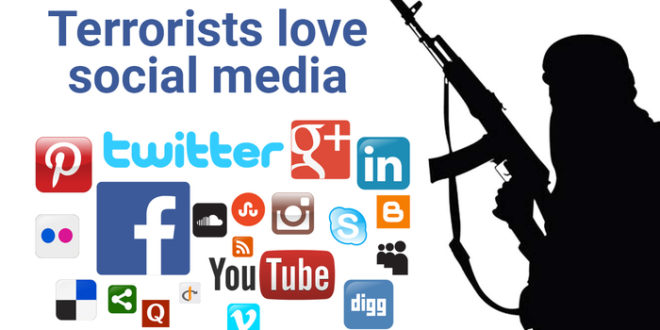Sajad Abedi[1] / Mohammad Amin Zabihi[2]
Terrorism is not a new phenomenon; our world has experienced different acts of terror since the peasant wars in ancient times to systematic acts of terror through religious-political agendas in modern days. Arguably, Terrorism, like any other phenomenon on the planet, has enjoyed the evolution process during the course of history. The focus of this paper is dedicated to modern technological tactics of religious terrorists in Social Media which have, in its own ways, changed the trend of this phenomenon in recent decades. The subject of interest in this paper, thus, is the impact of exploitation of Social Media on the expansion of terrorism on global scale. Nevertheless, the main aim is to shed the light on the fact that “the exploitation of social media by terrorist groups and organizations, spreads terrorism and insecurity”.
At the first step, one should consider the fact that the evolution of terrorism has occurred on two basis: (1) the very ideologies and believes – of course, this has happened in its own ways regarding any school of thought accordingly; for example, in religious fundamentalism, racism, or other concepts which have shaped different forms of terrorism; (2) the very nature of terrorism and the tools and equipment the perpetrators use in line with their agendas.
Investigating the first factor falls beyond the scope of the present paper. But, regarding the second factor: Terrorist organizations like ISIS or even minor local groups use these ICTs[3] to communicate, recruit members, spread their propaganda, to be heard and increase the blast of their actions, create terror within target societies, raise capital and gain financial support, and etc. In fact, ISIS has been repeatedly described as the most adept terrorist group at using Internet and social media propaganda to recruit new members (JOHNSON, 2016)[4]. On the other hand, the competitive nature of the relationship among terrorist groups somehow accelerates their exploitation of social media in almost every possible way. Nevertheless, their aims are clear as mentioned above, and their tools are online social media; but why? Because it’s (1) cheap; (2) accessible and easy to employ and use; (3) better for hiding the identity and even disguise; (4) makes it easier to reach out for a whole large community of users; (5) there is no need for physical presence and accessible almost anywhere on the planet; (6) (on the operational level) easier and also a lot safer to communicate through mobile app messengers.
In fact, one cannot completely deny the psychological influence of online propaganda and extreme contents which are being uploaded and disseminated by the terrorists through the social media. On the other hand, no one can deny the fact that social media and instant messenger platforms have facilitated the communication and coordination, even for terrorists. However, there are skeptical views regarding the degrees of such influence, and whether it can motivate individuals to commit horrifying actions or not. From the writer’s point of view, given the significant instances of “Lone Wolf attacks” which are carried out by individuals who have no direct contact with terrorist cells, no record of visiting crisis zones, no previous militia or combat trainings, no knowledge about guns or explosives, and yet committing such horrifying acts just due to inspirations of a magazine[5] or contents of a Telegram channel, such extreme skeptical views are redundant. Lone wolves are the clear evidence of the impact of online propaganda. According to the surveys carried out by European Union[6], a considerable portion of people actually follow online religious contents on cyberspace; on the other hand, the proper Internet Access facilitates this access. Looking at the picture from another angel, one will notice the significant portion of foreign fighters’ flow toward crisis zones, and also the new instances of terrorist attacks at the very heart of the West. All in one picture, there are undeniable signs of the role of cyberspace (especial social media platforms) as a facilitator in the expansion of terrorism and fundamentalism.
The reason why this approach could actually influence individuals, even in a Christian Club like EU, must be investigated through multidisciplinary researches, and such explanatory approach requires psychological evaluation of those who experienced this phenomenon and have been exposed to online extremist propaganda – whether predisposed ones, or those who had nothing to do with extremist beliefs. In order to grasp a better understanding of the situation we face, psychologists, sociologists, and other researchers in related fields must carry out interdisciplinary studies and comparative analyses in different groups, religions, and different countries.
But wat is clear in between, is the fact that nowadays no one can deny the influence of mass media, cyberspace, and online social media platforms on individuals and societies. It’s not a new phenomenon, but rather an old one which has experienced the process of evolution; according to Laqueur, “audio-cassettes of [Imam] Khomeini smuggled into Iran during his exile in Najaf and subsequently Paris significantly impacted the Iranian revolution” (Laqueur, The New Terrorism: Fanaticism and the Arms of Mass Destruction, 2000). It was long before the advent of online social media, what about now?
Thus, one can conclude that social media and cyberspace play a paramount role in promoting almost every aspect of the operational and recruitment strategies of terrorist organizations; whether directly in recruitment process, coordination and execution of a terrorist attack, and proceedings of organized crimes in different ways, or indirectly in radicalization of predisposed individuals and driving them towards malicious aims. In any case, cyberspace facilitates and furthers the evil aims of terrorists, no matter where they are or where it happens. It’s a two-edged knife and some serious precautions and protocols should be envisioned in this regard.
References
AL-BAYATI, H. (2017). A new counterterrorism strategy : why the world failed to stop al Qaeda and ISIS/ISIL, and how to defeat terrorists. California: Praeger. Retrieved 2018
JOHNSON, R. (2016). ISIS ONLINE: COUNTERING TERRORIST RADICALIZATION AND RECRUITMENT ON THE INTERNET AND SOCIAL MEDIA. Committee on Homeland Security and Governmental Affairs (pp. 114-453). Committee on Homeland Security and Governmental Affairs.
Laqueur, W. (2000). The New Terrorism: Fanaticism and the Arms of Mass Destruction. New York: Oxford University Press. Retrieved from https://books.google.com/books/about/The_New_Terrorism.html?id=XDax9YZpJpsC
Rahmatov, F., & Bolotova, A. (2019). Information flows and Radicalization leading to violent extremism in Central Asia. EU: European Union. Retrieved from https://internews.org/resource/information-flows-and-radicalization-leading-violent-extremism-central-asia
[1] PhD. in National Security Studies
National Defense and Security Think- Tank
Email Address:
[2] MA student in Regional Studies
Allameh Tabataba’i University
Email Address:
[3] Information and Communications Technology[4] ISIS is also the richest terrorist organization throughout the history (AL-BAYATI, 2017); thus, it has all the requirements needed for employing desired tools and equipment.
[5] Between 2014 to 2016, ISIS has published three different magazines (also available online) in three different languages: Dabiq in English, Dar al Islam in French, and Istok in Russian (Gramaccia & Campana, 2017).
[6] P
 Geostrategic Media Political Commentary, Analysis, Security, Defense
Geostrategic Media Political Commentary, Analysis, Security, Defense





